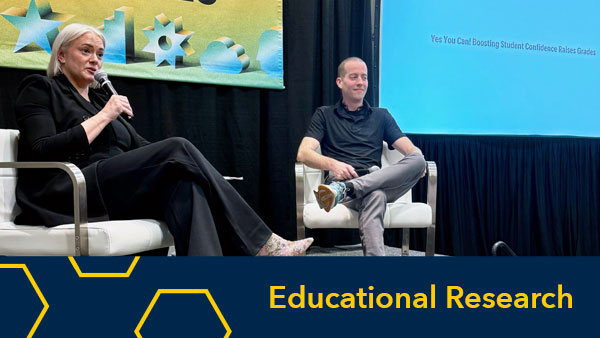Adam Levick, Data Scientist
@adlevick
Rebecca Quintana, Learning Experience Designer
@rebquintana
Stephanie Haley, Engagement & Iteration Manager
@stephrwooten
*Academic Innovation presented a related case study at CHI 2017: “The Persona Party: Using Personas to Design for Learning at Scale”*
Think back to the last time you stayed in someone else’s house/apartment without them there to host you. When you went to make yourself something to eat, you probably realized you had no idea where to find the right food! Sure, you had a general idea that perishable food would be in the refrigerator, but when it comes to finding specific items, especially a less frequently used kitchen tool, you became a drawer-pulling, cupboard-slamming machine! At your house it would have been obvious; the potato masher clearly goes behind the third pot on the right, but your friend hangs it above the sink! In the end, navigating and using your friend’s house was a big challenge. But you accepted it, because it was designed by them, for them.
This common situation, becoming lost in someone else’s design, illustrates one of the major reasons why the building of “personas” has become so prevalent and popular in the design world. It is also why we choose to apply them to digital tools and explore their use in online learning environments. As user experience professionals, our community acknowledges the value of utilizing personas for online learning contexts, but because this approach is under-explored, we also recognize the need to adapt this methodology to create our own novel approaches.
Personas offer realistic portraits of users at critical junctions in the design process, and have been doing so since the 90s when they were first implemented in their modern form. A persona contains information such as a user’s name, identity, behaviors, and motivations, as well as provides insight about what is important to them and how they experience similar technologies in everyday life. However, instead of representing one individual, a persona represents common traits of different audience segments, helping designers to make/prioritize decisions. This information is based on real data, often interviews and surveys of the target audience. When multiple personas are created for a project, one is often chosen as the primary persona, helping the design team to streamline goals and avoid self-referential design (designing for one’s own needs). Building a kitchen layout with a specific persona, with specific needs, in mind would have avoided the challenges illustrated earlier. It may sound counterintuitive, but case studies have shown that designing with a primary persona in mind improves the experience for all users.
 Personas for Learning Tools at DIG
Personas for Learning Tools at DIG
At the Digital Innovation Greenhouse, personas have always been a key part of the design process for the digital tools the lab helps scale. Mike Wojan, UX Designer, describes the role personas play:
“We often create personas of students and faculty that come into the office to give us feedback on our projects. This helps us stay in tune with users on campus so we know we’re developing tools that solve the right problems. Creating something that’s attractive and intuitive to the design team doesn’t necessarily mean you’ve delivered a product that meets the unique requirements of your end users. The best way to put ourselves in our users’ shoes is to create visual reminders of who they are and what’s important to them in the application. This way we can ask questions like, “what would Alex need from this part of the interface?,” or “how can we best serve Jane with this functionality? These processes have helped drive adoption and positive feedback across all of our DIG tools.”
Personas, along with other user-centered design methodologies, help drive positive feedback and adoption for many DIG tools. If you’re interested in why personas are so ubiquitous in the tech industry, this blog post outlines quantitative examples of their success.
Adapting to MOOCs
We’ve gathered a list of some of the unique challenges that arise in the design of online learning environments:
- Learners enter Massive Online Open Courses with a more diverse range of goals (career, enrichment, community, co-enrollment) than in traditional courses
- By necessity, much of the course design and creation needs to be done prior to a learner even starting to engage with materials and their peers
- Because content is pre-recorded, the instructor is not able to make changes “on the fly” or adapt materials to the emerging needs of learners
- Course instructors and staff likely base decisions on the kinds of learners that they have seen in their own face-to-face courses or, at worst, on their own personal preferences
We believe that integrating personas into the design process, both throughout the design of a course and during its iteration, has great potential to improve learner experience and outcomes. In the fall of 2016, we began running “Persona Parties” to introduce personas into our MOOC design process with the goal of being more intentional in our approach to creating learner-centered experiences in our courses. Personas Parties are collaborative sessions in which staff with various areas of expertise have developed the following types of personas:
- Aspirational – based on the goals of the course creator
- Assumptive – based on generalizable data from those assumed most likely to participate
- Data-Informed – based on data from the course or similar past courses
Personas in Practice
 The first “Persona Party” we ran centered on creating personas for use in future iterations of the Finance for Everyone: Smart Tools for Decision Making MOOC. Stephanie Haley and Mike Wojan provided a b
The first “Persona Party” we ran centered on creating personas for use in future iterations of the Finance for Everyone: Smart Tools for Decision Making MOOC. Stephanie Haley and Mike Wojan provided a b
rief introduction on personas and their traditional usage in the design process to the 19 team members who participated in the workshop. These participants were divided into four groups, each with at least one member with experience creating personas. The groups were provided with demographic data from pre-course surveys from both iterations of the MOOC, a persona design template, and background information about the instructor’s intended audience. Each group was instructed to create two personas that could inform the next iteration of the MOOC. The four participant groups created between 1-3 personas each, with 9 personas created in total. At a later design session, we shared these personas with the course instructor, Gautam Kaul, who selected “Joe Westfield” as the primary persona for future iterations of the course. Gautam later reflected:
“I liked Joe because he has no background in finance but has the right (and real) motivation for learning – managing his money and saving for an investment (education) in his children….To my mind, motivation is the key to learning.”
This persona will be a part of the design discussion for future iterations of this course.
In a second example, instead of going through the persona party process outlined above, we helped students create personas in Act on Climate: Steps to Individual, Community and Political Action, a MOOC that is being designed by Michaela Zint and a group of U-M students from the School of Natural Resources and the Environment. We gave each student in the course a template to guide them in creating an “aspirational” persona, whose characteristics are based on the type of learner that students are hoping to engage. During a class-wide discussion, students shared their personas and clustered them based on common traits. The largest cluster contained personas who were motivated to take action based on the political climate, followed by a cluster of those who were about to undertake a new challenge, such as enrolling in a new university program. Students chose one persona from each cluster, and these personas formed the primary and secondary personas represented by learners named Alex and Iram. Throughout the design sessions, we have observed students spontaneously referring to Alex and Iram when making design decisions. For example, the students are providing MOOC learners with lists of recommendations for personal actions that learners can take. For each recommendation, students have asked “does this recommendation seem like something Alex or Iram could or would want to do?”
With early success in implementing personas in the design process of our Massive Online Open Courses, we look forward to working with our faculty partners to implement this practice in more of our courses in order to create better experiences for our learners.
Adam Levick and Stephanie Haley both hold Master of Science in Information degrees in Human Computer Interaction. Rebecca Quintana holds a Master of Arts in Education and is currently pursuing a PhD in Educational Technologies.
 “I liked Joe because he has no background in finance but has the right (and real) motivation for learning – managing his money and saving for an investment (education) in his children….To my mind, motivation is the key to learning.”
“I liked Joe because he has no background in finance but has the right (and real) motivation for learning – managing his money and saving for an investment (education) in his children….To my mind, motivation is the key to learning.” 

